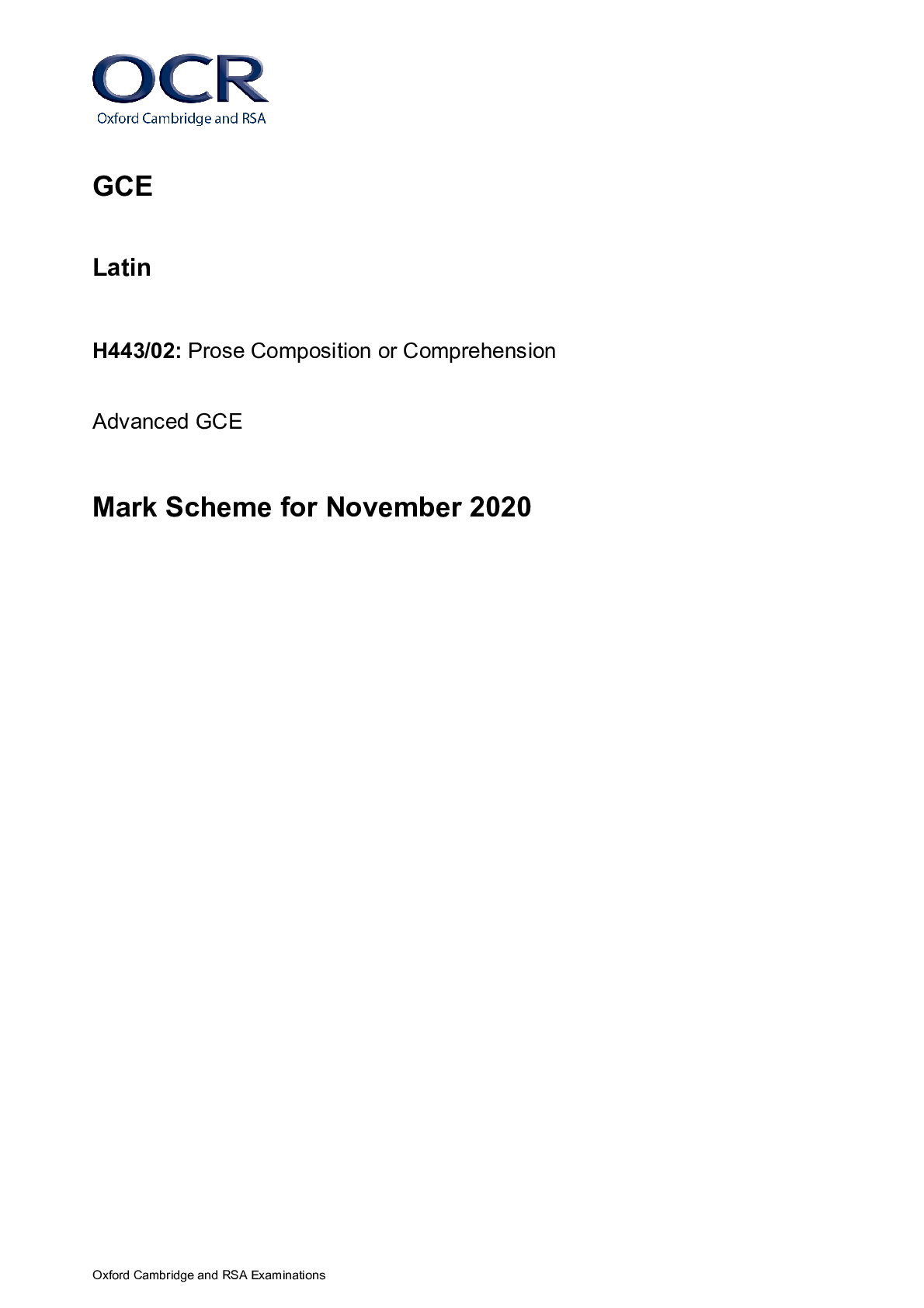Classical Civilisation > GCSE MARK SCHEME > GCSE (9–1) Classical Civilisation J199/12: Women in the ancient world General Certificate of Secon (All)
GCSE (9–1) Classical Civilisation J199/12: Women in the ancient world General Certificate of Secondary Education Mark Scheme for November 2020
Document Content and Description Below
GCSE (9–1) Classical Civilisation J199/12: Women in the ancient world General Certificate of Secondary Education Mark Scheme for November 2020 Oxford Cambridge and RSA Examinations GCSE (9–1) C... lassical Civilisation J199/12: Women in the ancient world General Certificate of Secondary Education Mark Scheme for November 2020Oxford Cambridge and RSA Examinations OCR (Oxford Cambridge and RSA) is a leading UK awarding body, providing a wide range of qualifications to meet the needs of candidates of all ages and abilities. OCR qualifications include AS/A Levels, Diplomas, GCSEs, Cambridge Nationals, Cambridge Technicals, Functional Skills, Key Skills, Entry Level qualifications, NVQs and vocational qualifications in areas such as IT, business, languages, teaching/training, administration and secretarial skills. It is also responsible for developing new specifications to meet national requirements and the needs of students and teachers. OCR is a not-for-profit organisation; any surplus made is invested back into the establishment to help towards the development of qualifications and support, which keep pace with the changing needs of today’s society. This mark scheme is published as an aid to teachers and students, to indicate the requirements of the examination. It shows the basis on which marks were awarded by examiners. It does not indicate the details of the discussions which took place at an examiners’ meeting before marking commenced. All examiners are instructed that alternative correct answers and unexpected approaches in candidates’ scripts must be given marks that fairly reflect the relevant knowledge and skills demonstrated. Mark schemes should be read in conjunction with the published question papers and the report on the examination. © OCR 2020J199/12 Mark Scheme November 2020 2 Annotations Annotation Meaning Blank Page Seen Tick Questionable response Incorrect Unclear Omission Repetition Benefit Of Doubt Too Vague SpellingJ199/12 Mark Scheme November 2020 3 1.Subject Specific Marking Instruction Introduction Your first task as an Examiner is to become thoroughly familiar with the material on which the examination depends. You should ensure that you have copies of these materials: • the specification, especially the assessment objectives • the question paper and its rubrics • the mark scheme. You should ensure also that you are familiar with the administrative procedures related to the marking process. These are set out in the OCR booklet Instructions for Examiners. If you are examining for the first time, please read carefully Appendix 5 Introduction to Script Marking: Notes for New Examiners. Please ask for help or guidance whenever you need it. Your first point of contact is your Team Leader. Using the Mark Scheme Please study this Mark Scheme carefully. The Mark Scheme is an integral part of the process that begins with the setting of the question paper and ends with the awarding of grades. Question papers and Mark Schemes are developed in association with each other so that issues of differentiation and positive achievement can be addressed from the very start. This Mark Scheme is a working document; it is not exhaustive; it does not provide ‘correct’ answers. The Mark Scheme can only provide ‘best guesses’ about how the question will work out, and it is subject to revision after we have looked at a wide range of scripts. The Examiners’ Standardisation Meeting will ensure that the Mark Scheme covers the range of candidates’ responses to the questions, and that all Examiners understand and apply the Mark Scheme in the same way. The Mark Scheme will be discussed and amended at the meeting, and administrative procedures will be confirmed. Co-ordination scripts will be issued at the meeting to exemplify aspects of candidates’ responses and achievements; the co-ordination scripts then become part of this Mark Scheme. Before the Standardisation Meeting, you should read and mark in pencil a number of scripts, in order to gain an impression of the range of responses and achievement that may be expected. Please read carefully all the scripts in your allocation and make every effort to look positively for achievement throughout the ability range. Always be prepared to use the full range of marks.J199/12 Mark Scheme November 2020 4 Question Indicative Content Marks (AO) Guidance Section A 1 Name the god of wine who was worshipped by female followers. Dionysus (1) 1 (AO1) 2 What is the correct name for the staff that the female followers of this god carried? Thyrsus (1) 1 (AO1) 3a What was the name given to the female worshippers, like the one shown in the source? Maenad (1) Bacchantes (1) [1 max] 1 (AO1) 3b How you can tell the woman in Source A belongs to this group? Make two points. Do not refer to the staff she is holding. Hair (1), holding a leopard (1), wild pose (1), bare feet (1), wearing animal skins (1), dancing (1) [2 max] 2 (AO1) 4a (i) What type of dish is the image painted on? Cup (1), Kylix (1) [1 max] 1 (AO1)J199/12 Mark Scheme November 2020 5 4a (ii) What would it have contained when it was used? Wine (1) 1 (AO1) 4b Why was this significant? Dionysos was the god of wine (1) 1 (AO2) The ‘indicative content’ is a description of possible content only; all legitimate answers and approaches must be credited appropriately. 5a Describe the mythical event was celebrated in the Thesmophoria festival. Make two points. Abduction of Persephone (1) by Hades (1), descent into the Underworld (1) return from Underworld (1), cause of spring/autumn (1) [2 max] 2 (AO1) 5b Why was this myth significant for the Greeks? Important for crops/harvest (1) Explained the change of seasons (1) [1 max] 1 (AO2) The ‘indicative content’ is a description of possible content only; all legitimate answers and approaches must be credited appropriately. 6a Describe one ritual that was performed by women at the Thesmophoria. Ashes (1), sacrifice of piglet (1), burial/retrieval of remains (1), speaking insults/obscenities (1) [1 max] 1 (AO1)J199/12 Mark Scheme November 2020 6 6b Why did they do this? To please the gods (1), to mourn Persephone (1), offering to Hades (1), because it was traditional (1), reason not known – mystery cult (1) [1 max] 1 (AO1) The ‘indicative content’ is a description of possible content only; all legitimate answers and approaches must be credited appropriately. 7 What is the name of the woman shown sitting down in this image? Hegeso (1) 1 (AO1) 8 What can we tell about both women from the way they have been shown? Make three points. Left hand figure – slave as she is standing (1), has plain clothing (1) Right hand figure – rich as she is seated (1), is admiring jewellery/rich (1), has elaborate clothing (1), has fancy hairstyle (1) [3 max] 3 (AO1) Credit any relevant point drawn from the source. Answers should refer to both figures in order to attain maximum marks. 9a What type of ceremony is shown here? Funeral (1) Mourning (1) [1 max] 1 (AO1)J199/12 Mark Scheme November 2020 7 9b How can you tell? Make two points. Gesture of raised hands (1), tearing hair (1), dark clothing (1) [2 max] 2 (AO1) 10 What responsibilities did women have in preparing for this ceremony? Make two points. Wash the body (1), anoint the body with perfumed oils (1), clothe the body in a white shroud (1), garland the body with flowers (1), place a coin in the mouth (1) [2 max] 2 (AO1) 11 ‘The most important reason for young Athenian and Spartan women to get married was to have children.’ How far do you agree with this statement? Use Source D as a starting point and your own knowledge in your answer. AO1 Candidates might show knowledge and understanding of: • Athens o Girls educated from a young age that marriage was a priority and to aspire to be a kyria (married woman) o importance of legitimacy of children in Athenian law (e.g. Neaira court case) o girls educated to manage an oikos (household) o admission to religious cults (eg Thesmophoria only open to married women) o social respectability of status of married women, especially when compared to slaves, prostitutes and hetairai (courtesans) o living with and working with her husband to run the oikos; o importance of the dowry o uniting familes/business/political reasons 4 (AO1) 4 (AO2) The ‘indicative content’ is a description of possible content only; all legitimate answers and approaches must be credited appropriately.J199/12 Mark Scheme November 2020 8 • Sparta o Men remained living in barracks (syssitia) even when married o focus on role of women to produce babies o marriage of minimal importance o women apparently encouraged to sleep with men other than their husbands in order to produce children o no dowry AO2 Candidates may demonstrate evaluation and analysis through the use of some of the following arguments: • Athens o increase family’s wealth/prestige through link with another oikos (household/family) o giving birth important to continuing family line; o considered respectable o comparison with low status of unmarried women; o dowry crucial to the wider family o Husband selected by the bride’s kyrios (father/head of household) Sparta o source shows priority of sexual relations (to produce sons for the army) o source shows absence of any family involvement o source shows men did not live with their wives o source demonstrates absence of any personal emotions/feelings in the relationship; o main priority for Spartan women was to produce babies Guidance on applying the marking grids for the 8-mark detailed response Two Assessment Objectives are being assessed in this question: AO1 (Demonstrate knowledge and understanding…) and AO2 (Analyse, interpret and evaluate…). The two Assessment Objectives are equally weighted, and both worth 4 marks. The weighting of assessment objectives remains consistentJ199/12 Mark Scheme November 2020 9 throughout the levels. Responses are credited for AO1 for the detail and accuracy of the knowledge of the sources, their context and interpretation. Responses are credited for AO2 for how well the question is addressed, selecting relevant evidence from the sources and the conclusions drawn. Examiners must use a best fit approach when applying the mark scheme. This means considering both the strengths and the weaknesses of a response, particularly if it is imbalanced in terms of the two assessment objectives, when deciding which level reflects the overall performance. AO1 and AO2 are closely interlinked. Typically responses demonstrate both knowledge and understanding and analysis and interpretation of that knowledge in reasonably equal measure. In this way, a total mark of 6 might reflect a balance of 3 (AO1) + 3 (AO2), for example. However, an overly-descriptive response may focus on details from the sources but not draw many valid conclusions; this would be considered AO1 heavy. Care should be taken when marking such answers, as the lack of AO2 skills should limit the level at which this work can be rewarded; it should not be possible to achieve a mark of 7 made up of 6 (AO1) + 1 (AO2). Examples of specific issues or common unbalanced approaches to the question will be identified when finalising the mark scheme in preparation for standardisation. Details about how to deal with this will be included in the Guidance column for the question. Level Mark Characteristics of Performance 4 7–8 • consistently accurate and detailed knowledge and understanding of classical sources, using both those given in assessment and own wider knowledge (AO1) shows very good understanding of the sources’ cultural contexts and possible interpretations • a well-argued response to the question which is supported by a range of well-selected evidence (AO2) includes critical analysis, interpretation and evaluation 3 5–6 • accurate knowledge and understanding of classical sources, using both those given in assessment and own wider knowledge (AO1) shows good understanding of the sources’ cultural contexts and/or possible interpretations • a focused response to the question which is supported by a range of evidence (AO2) includes relevant analysis, interpretation and evaluation 2 3–4 • sound, mostly accurate, knowledge and understanding of classical sources, using both those given in assessment and own wider knowledge (AO1) shows some understanding of the sources’ cultural contexts and/or possible interpretations • engages with the general topic of the question, and is supported by limited range of evidence (AO2) includes some analysis, interpretation and evaluation 1 1–2 • limited knowledge and understanding of classical sources; responses may only make use of the sources given in the assessment (AO1) shows limited understanding of the sources’ cultural contexts and/or possible interpretations • little attempt at a very basic explanation of the topic of the question, supported by a few references to evidence (AO2) includes isolated analysis, interpretation and evaluation 0 0 • No response or no response worthy of creditJ199/12 Mark Scheme November 2020 10 Question Section B Indicative Content Marks (AO) Guidance 12a What sort of woman is portrayed here by the artist? Rich (1), respectable (1), powerful (1), matrona (1) [max 1] 1 (AO1) 12b How do you know from this source? Make two points. Pose (1), clothing (1), hair covered (1), diadem (1) [max 2] 2 (AO1) 13 List any two duties that the woman shown in Source E would be expected to carry out in the home. Raise children (1), organise dinner parties (1), run household (1), present herself well to impress clients (1) [max 2] 2 (AO1) Do not credit tasks typically carried out by slaves (eg cooking, cleaning and child-care). 14 What type of wedding ceremony is shown here? confarreatio (1) Accept coemptio (1) [max 1] 1 (AO1) 15 List the two types of marriages that were recognised by the Romans. Cum manu [‘with hand’] (1) and sine manu [‘without hand’] (1) 2 (AO1) Accept answers in English. Whichever of the two answers possible in Q14 that wasn’t chosen in that question should be allowed here. Accept usus as an alternative idea.J199/12 Mark Scheme November 2020 11 Accept explanation of cum manu and sine manu without the terms 16a The girl in Source G is making a journey. Where is she travelling from and to? From her parents’/paterfamilias’ house (1) to the house of the groom’s family/new house (1) 2 (AO1) 16b Why is this journey significant? Symbolises passing from one family to another (1), from her own paterfamilias to her husband or husband’s paterfamilias (1) [max 1] 1 (AO2) The ‘indicative content’ is a description of possible content only; all legitimate answers and approaches must be credited appropriately. 17a Roman girls rarely chose who they married. Who usually made this decision for them? Paterfamilias (1), father (1), head of family (1) [max 1] 1 (AO1) 17b Suggest two advantages of this system. Business partnerships or arrangements (1), political alliances (1), social standing (1), dowry protected the bride to a degree (1) [max 2] 2 (AO1) The ‘indicative content’ is a description of possible content only; all legitimate answers and approaches must be credited appropriately. 18 Why was chastity an important virtue for women in ancient Rome. Make two points. Ensured the legitimacy of children (1), property rights (1), demonstrated respectability (1), honour (1) [max 2] 2 (AO1) The ‘indicative content’ is a description of possible content only; all legitimate answers and approaches must be credited appropriately.J199/12 Mark Scheme November 2020 12 19a Pliny states that his wife “sits discretely behind a curtain”. Why does she avoid being seen? Make two points. Out of sight of his guests (1), shows modesty (1) [max 2] 2 (AO1) The ‘indicative content’ is a description of possible content only; all legitimate answers and approaches must be credited appropriately. 19b What does this suggest about her character? Respectable (1), from good family (1), intellectual curiosity (1) [max 1] 1 (AO2) The ‘indicative content’ is a description of possible content only; all legitimate answers and approaches must be credited appropriately. 20 How typical is Pliny’s wife’s ability to read? Justify your answer. Typical for rich women (1), because they were educated (1), not for poor women (1), because school was expensive (1), evidence of some girls taught by litterator (1), overall appears to be reasonably typical (1), likely poor women could read to an extent (1), “Sappho” fresco shows a woman who could read (1) [max 3] 3 (AO1) 21 ‘Sempronia’s behaviour is the opposite of how women were expected to behave in ancient Rome.’ How far do you agree with this statement? Use Source I as a starting point and your own knowledge in your answer. AO1 Candidates might show knowledge and understanding of: • Expected behaviour could include: o Modesty o Obedience o Working with wool including weaving o Produce and raise children o Run the household (including managing slaves) o Rich women could attend religious festivals, public games and the theatre o Managing dinner parties to entertain clients 8 (See LoR) The ‘indicative content’ is a description of possible content only; all legitimate answers and approaches must be credited appropriately.J199/12 Mark Scheme November 2020 13 o Some women owned property and ran businesses in their own right AO2 Candidates might demonstrate evaluation and analysis through the use of some of the following arguments: • The source’s description of Sempronia’s behaviour: o “committed crimes” suggests women expected to be law-abiding o “manly audacity” suggests women not expected to behave like men o “more elegant than an honest woman” suggests flirtatious behaviour o “life of luxury” suggests women expected to live within modest means o “careless of money/reputation” suggests women expected to be the opposite o “lustful nature” suggests women not expected to express sexuality On the other hand: o “well versed in Greek & Latin/music/dancing” Evidence of good education o “able to write poetry, tell a joke, speak modestly etc.” suggests these were skills which were praised in women Guidance on applying the marking grids for the 8-mark detailed response Two Assessment Objectives are being assessed in this question: AO1 (Demonstrate knowledge and understanding…) and AO2 (Analyse, interpret and evaluate…). The two Assessment Objectives are equally weighted, and both worth 4 marks. The weighting of assessment objectives remains consistent throughout the levels. Responses are credited for AO1 for the detail and accuracy of the knowledge of the sources, their context and interpretation. Responses are credited for AO2 for how well the question is addressed, selecting relevant evidence from the sources and the conclusions drawn. Examiners must use a best fit approach when applying the mark scheme. This means considering both the strengths and the weaknesses of a response, particularly if it is imbalanced in terms of the two assessment objectives, when deciding which level reflects the overall performance. AO1 and AO2 are closely interlinked. Typically responses demonstrate both knowledge and understanding and analysis and interpretation of that knowledge in reasonably equal measure. In this way, a total mark of 6 might reflect a balance of 3 (AO1) + 3 (AO2), for example. However, an overly-descriptive response may focus on details from the sources but not draw many valid conclusions; this would be considered AO1 heavy. Care should be taken when marking such answers, as the lack of AO2 skills should limit the level at which this work can be rewarded; it should not be possible to achieve a mark of 7 made up of 6 (AO1) + 1 (AO2). Examples of specific issues or common unbalanced approaches to the question will be identified when finalising the mark scheme in preparation for standardisation. Details about how to deal with this will be included in the Guidance column for the question.J199/12 Mark Scheme November 2020 14 Level Mark Characteristics of Performance 4 7–8 • consistently accurate and detailed knowledge and understanding of classical sources, using both those given in assessment and own wider knowledge (AO1) shows very good understanding of the sources’ cultural contexts and possible interpretations • a well-argued response to the question which is supported by a range of well-selected evidence (AO2) includes critical analysis, interpretation and evaluation 3 5–6 • accurate knowledge and understanding of classical sources, using both those given in assessment and own wider knowledge (AO1) shows good understanding of the sources’ cultural contexts and/or possible interpretations • a focused response to the question which is supported by a range of evidence (AO2) includes relevant analysis, interpretation and evaluation 2 3–4 • sound, mostly accurate, knowledge and understanding of classical sources, using both those given in assessment and own wider knowledge (AO1) shows some understanding of the sources’ cultural contexts and/or possible interpretations • engages with the general topic of the question, and is supported by limited range of evidence (AO2) includes some analysis, interpretation and evaluation 1 1–2 • limited knowledge and understanding of classical sources; responses may only make use of the sources given in the assessment (AO1) shows limited understanding of the sources’ cultural contexts and/or possible interpretations • little attempt at a very basic explanation of the topic of the question, supported by a few references to evidence (AO2) includes isolated analysis, interpretation and evaluation 0 0 • No response or no response worthy of creditJ199/11 Mark Scheme June 20XX 12 Question Indicative Content Marks (AO) Guidance Section C 22 Explain how this source shows that Pandora would have been desirable to Greek men. AO1: Two from: • She has the pretty form of a maiden (1) • She is able to spin (1) • She is modest (1) • Her bodily adornments (1) AO2: Two pairs from: • Greek men would want a beautiful wife (1) as it would improve their reputation (1) • Spinning was an important skill for a kyria to have (1) as it contributed to the self-sufficiency of the house (1) • Wives were supposed to be modest (1) to limit unwanted male attention (1) / to show that they were controlled by their husbands (1) • A wife who was dressed beautifully would show how her husband cared for her (1) / had high status (1) 2 (AO1) 4 (AO2) AO1 marks are awarded for the selection of material from the source, AO2 marks for the interpretation, analysis and evaluation of this. The indicative content is a description of possible content only; all legitimate answers and approaches must be credited appropriately. For each idea, there is one mark for use of the source, and two marks for opinions on this. 23 Explain what is happening to Tarpeia in this source, and why. AO1: • She is being killed by shields (shields is essential) (1) AO2: • She had let the enemy into the city (1) and was a traitor (1) 1 (AO1) 2 (AO2) AO1 marks are awarded for the selection of material from the source, AO2 marks for the interpretation, analysis and evaluation of this. The following is a description of possible content only; all legitimate answers andJ199/12 Mark Scheme November 2020 13 approaches must be credited appropriately. 24 Explain how both sources suggest that women could not be trusted. AO1: Two from (one from each source): • Pandora lies (1) • She has a thievish nature (1) • She has a bitch’s mind (1) • She is a bane to men (1) • Tarpeia is being killed (1) AO2: Two pairs from (one about each source): • Men would want an honest wife (1) as it would harm their reputation (1) • Pandora is seen to take from men (1) which would squander valuable resources (1) • Tarpeia had been trusted by the Romans (1) / she had been sent to gather water (1), but struck a deal with the enemy (1) 2 (AO1) 4 (AO2) AO1 marks are awarded for the selection of material from the source, AO2 marks for the interpretation, analysis and evaluation of this. The following is a description of possible content only; all legitimate answers and approaches must be credited appropriately.J199/12 Mark Scheme November 2020 14 25 “Prostitution was considered a respectable trade in both Athens and Rome.” Explain how far you agree with this statement. Answers might include reference to some of the following: AO1 Greece • The role and status of the pornai • The roles and status of the hetairai • Prostitutes were taxed by the state • Some brothels were state run • Most were in the slum areas • Life of Neaira • Life of Aspasia Rome • The role and status of the meretrix • The role and status of the lena • Prostitutes involved in Roman religious festivals (e.g. Fortuna Virilis) • Wore a toga • Brothels were often cramped and dingy • Life of Cytheris/Lycoris • Life of Clodia/Lesbia (Cicero compares her to a prostitute) AO2 • Word for prostitute could be used as an insult • Pornai were slaves and being a slave was not a respectable way of life for the Greeks • Prostituion was a normal part of everyday life. No stigma attached to visiting to a prostitute • Hetairai were admired for their intellectual ability (e.g. Aspasia had Socrates listen to her) • Brothels were is slum areas, perhaps to hide them away from the respectable parts ot town 15 (See Levels of Response grid) The ‘indicative content’ is a description of possible content only; all legitimate answers and approaches must be credited appropriately.J199/12 Mark Scheme November 2020 15 • Pimps were highly ridiculed in love poetry and comedy. They were seen as greedy and dishonest • Being involved in religion, and mixing with matronae, gave them a degree of respectability • A toga was a badge of shame to distinguish them by them not wearing respectable women’s clothing. • Antony had to break off his relationship with Cytheris as it was damaging for his public personaJ199/12 Mark Scheme November 2020 16 Guidance on applying the marking grids for the 15-mark extended response Two Assessment Objectives are being assessed in this question: AO1 (Demonstrate knowledge and understanding…) and AO2 (Analyse, interpret and evaluate…). The two Assessment Objectives are not equally weighted, as AO1 is worth 5 marks, and AO2 10. The weighting of assessment objectives remains consistent throughout the levels. Responses are credited for AO1 for the detail and accuracy of the knowledge of the sources, their context and interpretation. Responses are credited for AO2 for how well the question is addressed, selecting relevant evidence from the sources and the conclusions drawn. Examiners must use a best fit approach when applying the mark scheme. This means considering both the strengths and the weaknesses of a response, particularly if it is imbalanced in terms of the two assessment objectives, when deciding which level reflects the overall performance. AO1 and AO2 are closely interlinked. Typically responses demonstrate both knowledge and understanding and analysis and interpretation of that knowledge in reasonably equal measure. In this way, a total mark of 11 might reflect a balance of 3 (AO1) + 8 (AO2), for example. However, an overly-descriptive response may focus on details from the sources but not draw many valid conclusions; this would be considered AO1 heavy. Care should be taken when marking such answers, as the lack of AO2 skills should limit the level at which this work can be rewarded; it should not be possible to achieve a mark of 10 made up of 7 (AO1) + 3 (AO2). Examples of specific issues or common unbalanced approaches to the question will be identified when finalising the mark scheme in preparation for standardisation. Details about how to deal with this will be included in the Guidance column for the question. Level Mark Characteristics of Performance 5 13 – 15 • very good, detailed and accurate knowledge and understanding of classical sources with detailed understanding of the sources’ cultural contexts and possible interpretations (AO1) • very good analysis and interpretation of a wide range of well-selected evidence (AO2) • coherent argument with a clear line of reasoning, successful evaluation of sources, and convincing conclusions (AO2) 4 10 – 12 • good, accurate knowledge and understanding of classical sources with clear understanding of the sources’ cultural contexts and possible interpretations (AO1) • good analysis and interpretation of a wide range of relevant evidence (AO2) • consistently well-structured argument, consistent evaluation of sources, and sound conclusions (AO2) 3 7 – 9 • reasonable, mostly accurate, knowledge and understanding of classical sources with reasonable understanding of the sources’ cultural contexts and/or possible interpretations (AO1) • reasonable analysis and interpretation of a range of relevant evidence (AO2) • argument is on the whole appropriately structured, reasonable evaluation of sources, and relevant conclusions (AO2) 2 4 – 6 • basic knowledge and understanding of classical sources, with basic understanding of the sources’ cultural contexts and/or possible interpretations (AO1) • basic analysis and interpretation of some relevant evidence (AO2) • argument has some structure, some evaluation of sources, and some credible conclusions (AO2) 1 1 – 3 • limited knowledge and understanding of classical sources with little understanding of the sources’ cultural contexts and/or possible interpretations (AO1) • limited analysis and interpretation of little relevant evidence (AO2) • some attempt at reasoning, isolated use of sources, and weak conclusions (AO2) 0 0 • no response or no response worthy of creditJ199/12 Mark Scheme November 2020 17 Question Indicative Content Marks (AO) Guidance 26 “A small number of determined women were able to effect political change.” Explain how far you agree with this statement. Answers might include reference to some of the following: AO1 Greece • Assembly and political offices only open to male citizens • Trial of Agnodice • Aspasia’s influence over Pericles • Knowledge of plot of Assemblywomen Rome • Senate and political offices only open to male citizens • Stories of Praecia and Fabia • Repeal of the Oppian Law • Sempronia • Cleopatra • Sabine women • Lucretia AO2 • Women could not vote on any matters that affected their lives • Little evidence of women actually influencing Greek men. Hetairai were foreigners and while educated, may not have been to influence Greek politics • Pericles allegedly attacked Samos to gratify Aspasia • Agnodice did bring about a change in who could be a doctor, but it might be that the story is invented • Assemblywomen is clearly a farcical situation. The comedy derives from the events being totally ridiculous • Plenty of evidence of Roman women influencing husbands (credit 15 (See Levels of Response) The ‘indicative content’ is a description of possible content only; all legitimate answers and approaches must be credited appropriately. Credit discussion of women who may have brought about political change, even if they might not be seen as determined (e.g. prophecies of the Pythia influencing political and military decisions)J199/12 Mark Scheme November 2020 18 knowledge of imperial wives/mothers who had major influence) • Sabine women put an end to the war • Women in the Oppian Law did bring about a change, but this was only the noble women (though perhaps a sizeable number of them). Ordinary women would not be able to have any say. The law only affected noble women anyway • Sempronia did not really cause any political change and the conspiracy failed • Lucretia’s suicide brought about the end of the monarchy • Cleopatra could be partly responsible for the fall of the RepublicJ199/12 Mark Scheme November 2020 19 Guidance on applying the marking grids for the 15-mark extended response Two Assessment Objectives are being assessed in this question: AO1 (Demonstrate knowledge and understanding…) and AO2 (Analyse, interpret and evaluate…). The two Assessment Objectives are not equally weighted, as AO1 is worth 5 marks, and AO2 10. The weighting of assessment objectives remains consistent throughout the levels. Responses are credited for AO1 for the detail and accuracy of the knowledge of the sources, their context and interpretation. Responses are credited for AO2 for how well the question is addressed, selecting relevant evidence from the sources and the conclusions drawn. Examiners must use a best fit approach when applying the mark scheme. This means considering both the strengths and the weaknesses of a response, particularly if it is imbalanced in terms of the two assessment objectives, when deciding which level reflects the overall performance. AO1 and AO2 are closely interlinked. Typically responses demonstrate both knowledge and understanding and analysis and interpretation of that knowledge in reasonably equal measure. In this way, a total mark of 11 might reflect a balance of 3 (AO1) + 8 (AO2), for example. However, an overly-descriptive response may focus on details from the sources but not draw many valid conclusions; this would be considered AO1 heavy. Care should be taken when marking such answers, as the lack of AO2 skills should limit the level at which this work can be rewarded; it should not be possible to achieve a mark of 10 made up of 7 (AO1) + 3 (AO2). Examples of specific issues or common unbalanced approaches to the question will be identified when finalising the mark scheme in preparation for standardisation. Details about how to deal with this will be included in the Guidance column for the question. Level Mark Characteristics of Performance 5 13 – 15 • very good, detailed and accurate knowledge and understanding of classical sources with detailed understanding of the sources’ cultural contexts and possible interpretations (AO1) • very good analysis and interpretation of a wide range of well-selected evidence (AO2) • coherent argument with a clear line of reasoning, successful evaluation of sources, and convincing conclusions (AO2) 4 10 – 12 • good, accurate knowledge and understanding of classical sources with clear understanding of the sources’ cultural contexts and possible interpretations (AO1) • good analysis and interpretation of a wide range of relevant evidence (AO2) • consistently well-structured argument, consistent evaluation of sources, and sound conclusions (AO2) 3 7 – 9 • reasonable, mostly accurate, knowledge and understanding of classical sources with reasonable understanding of the sources’ cultural contexts and/or possible interpretations (AO1) • reasonable analysis and interpretation of a range of relevant evidence (AO2) • argument is on the whole appropriately structured, reasonable evaluation of sources, and relevant conclusions (AO2) 2 4 – 6 • basic knowledge and understanding of classical sources, with basic understanding of the sources’ cultural contexts and/or possible interpretations (AO1) • basic analysis and interpretation of some relevant evidence (AO2) • argument has some structure, some evaluation of sources, and some credible conclusions (AO2) 1 1 – 3 • limited knowledge and understanding of classical sources with little understanding of the sources’ cultural contexts and/or possible interpretations (AO1)J199/12 Mark Scheme November 2020 20 • limited analysis and interpretation of little relevant evidence (AO2) • some attempt at reasoning, isolated use of sources, and weak conclusions (AO2) 0 0 • no response or no response worthy of creditOCR (Oxford Cambridge and RSA Examinations) The Triangle Building Shaftesbury Road Cambridge CB2 8EA OCR Customer Contact Centre Education and Learning Telephone: 01223 553998 [Show More]
Last updated: 2 years ago
Preview 1 out of 25 pages
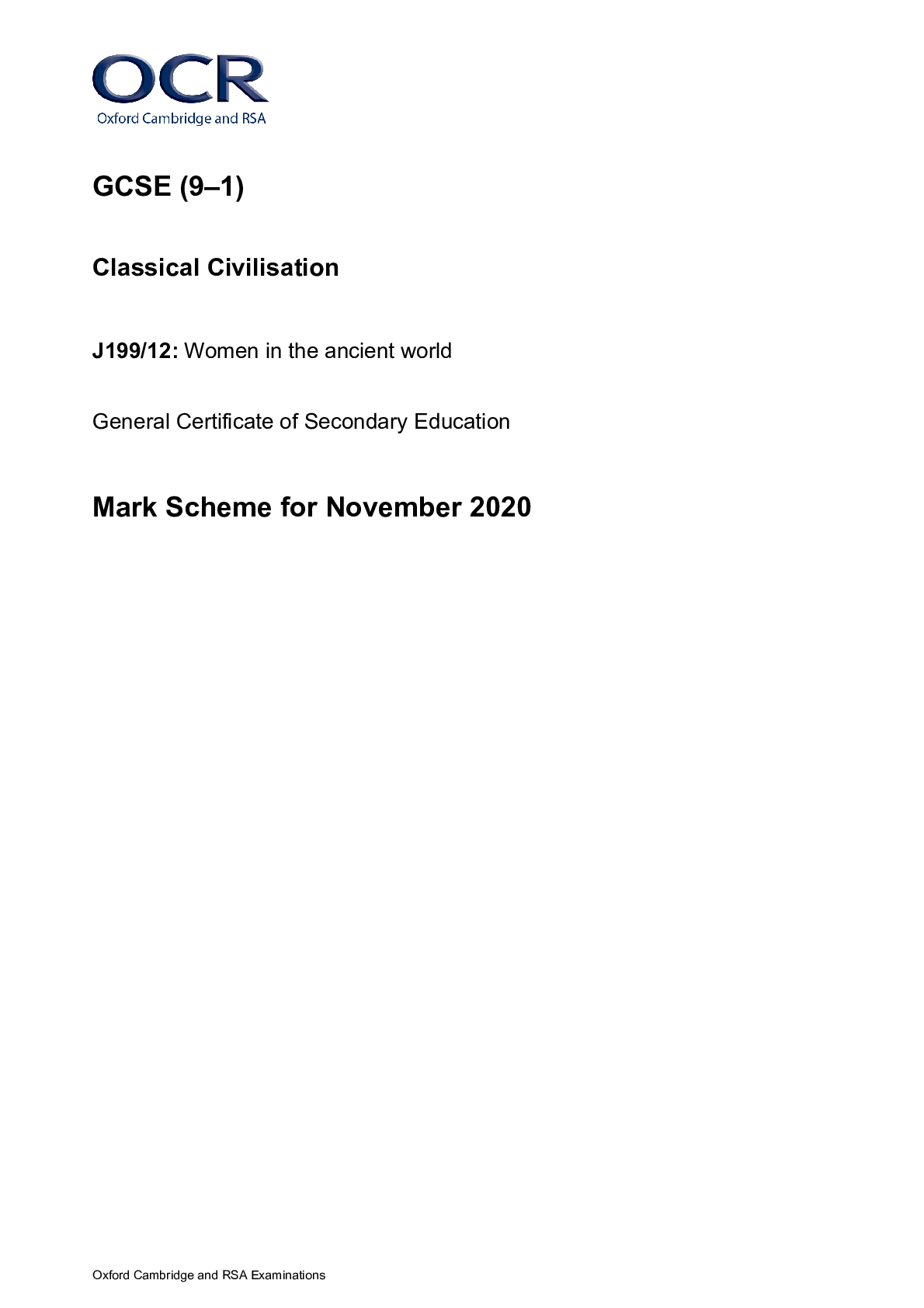
Buy this document to get the full access instantly
Instant Download Access after purchase
Buy NowInstant download
We Accept:

Reviews( 0 )
$7.00
Can't find what you want? Try our AI powered Search
Document information
Connected school, study & course
About the document
Uploaded On
Oct 07, 2022
Number of pages
25
Written in
Additional information
This document has been written for:
Uploaded
Oct 07, 2022
Downloads
0
Views
113

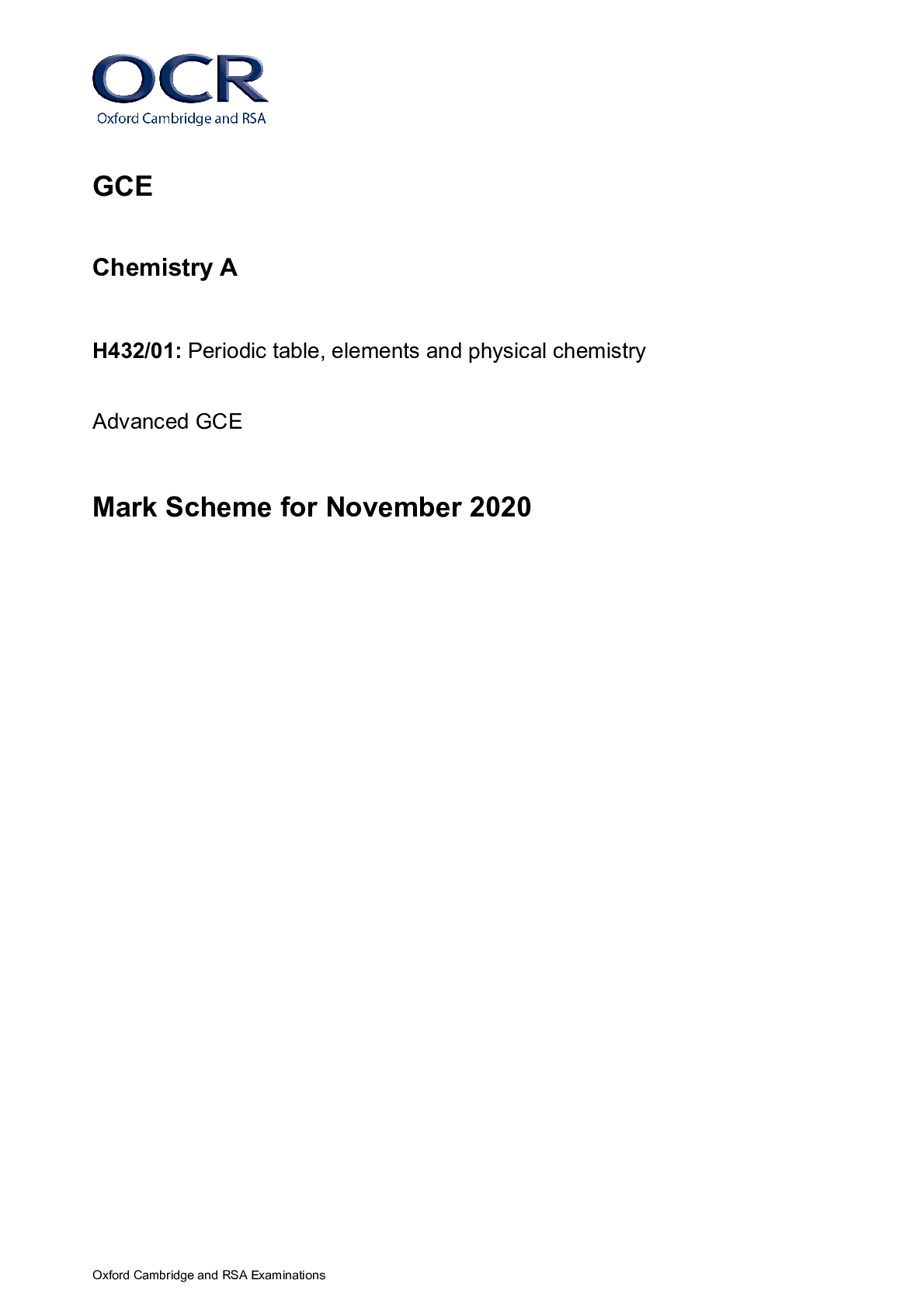
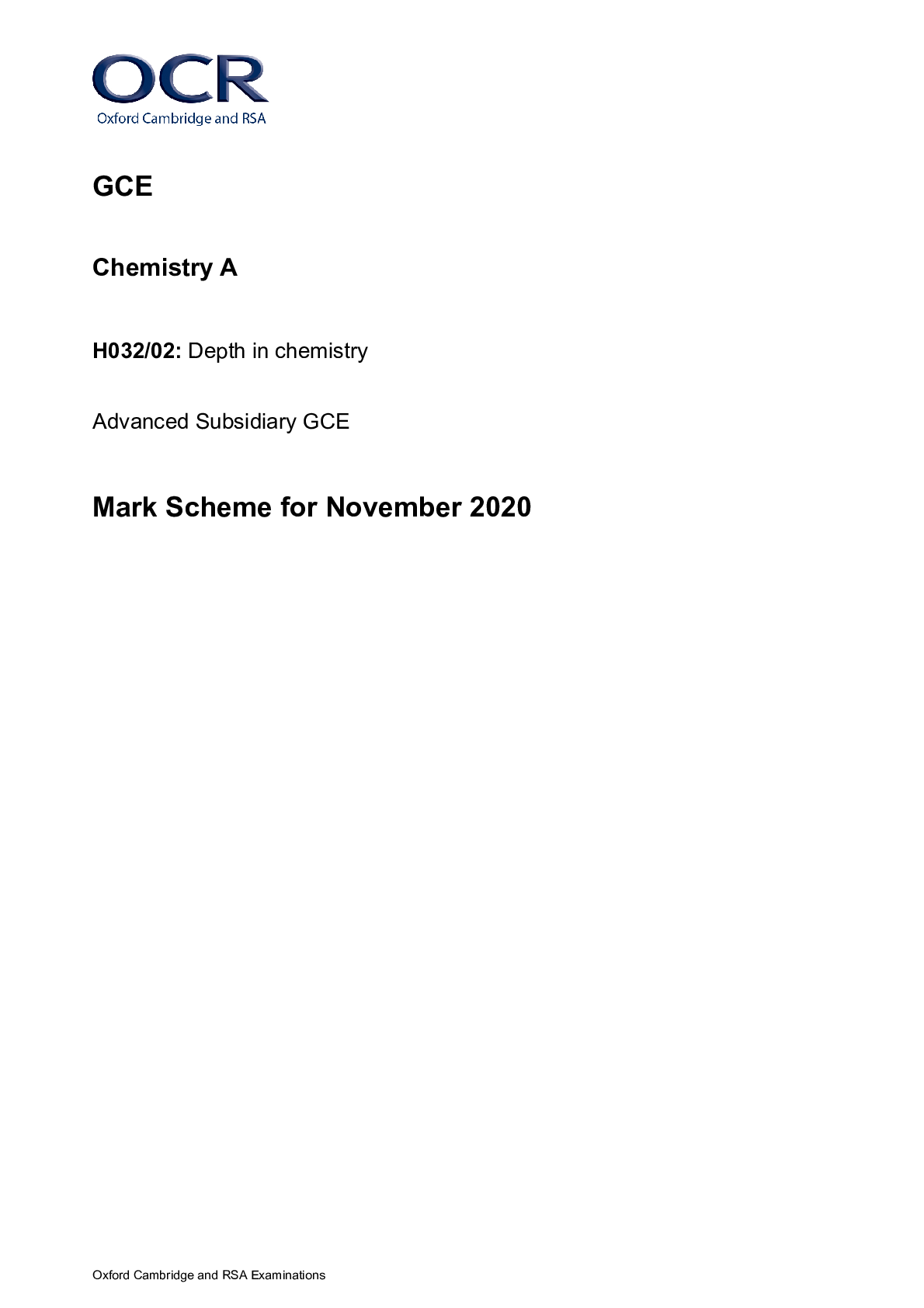

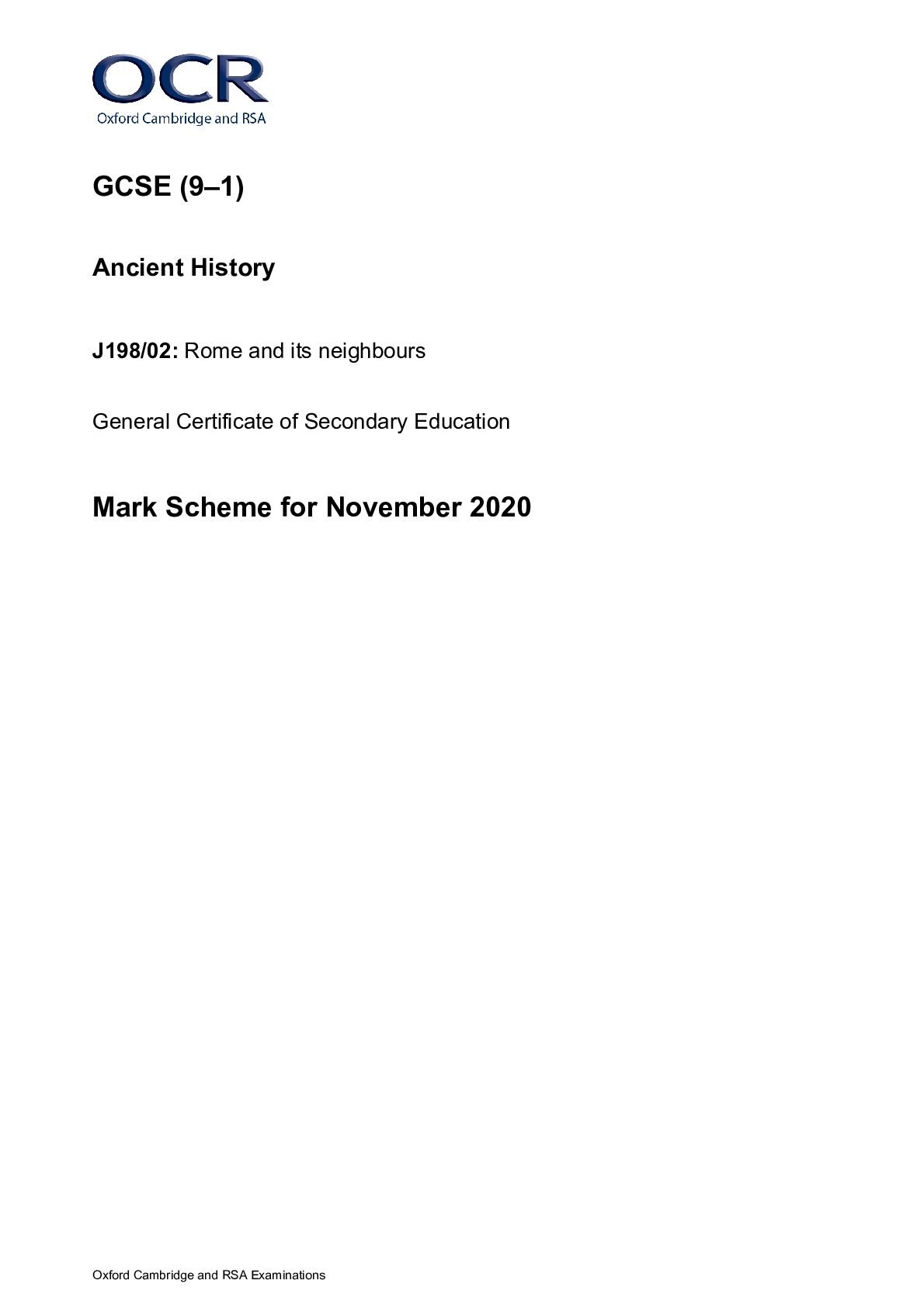




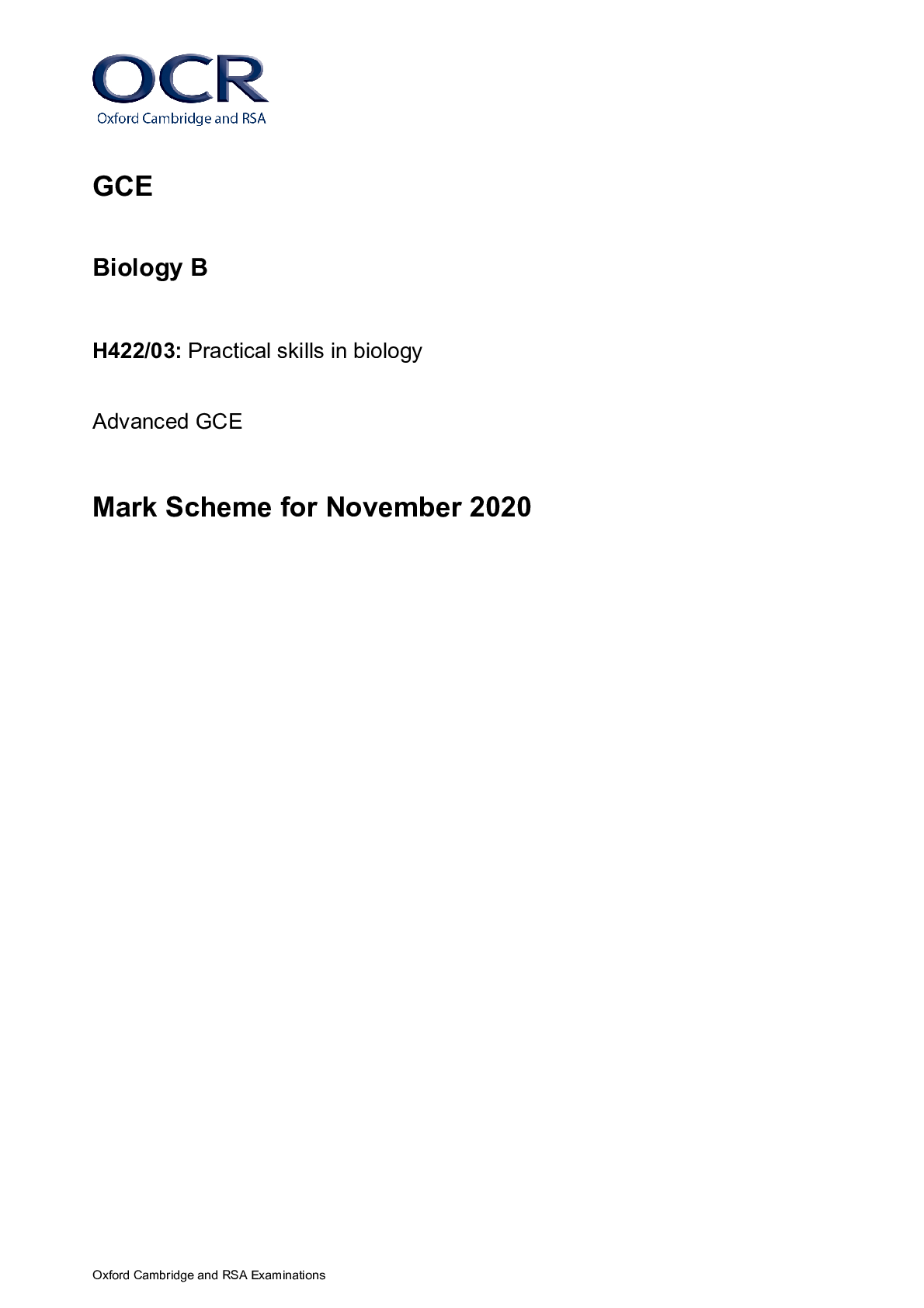
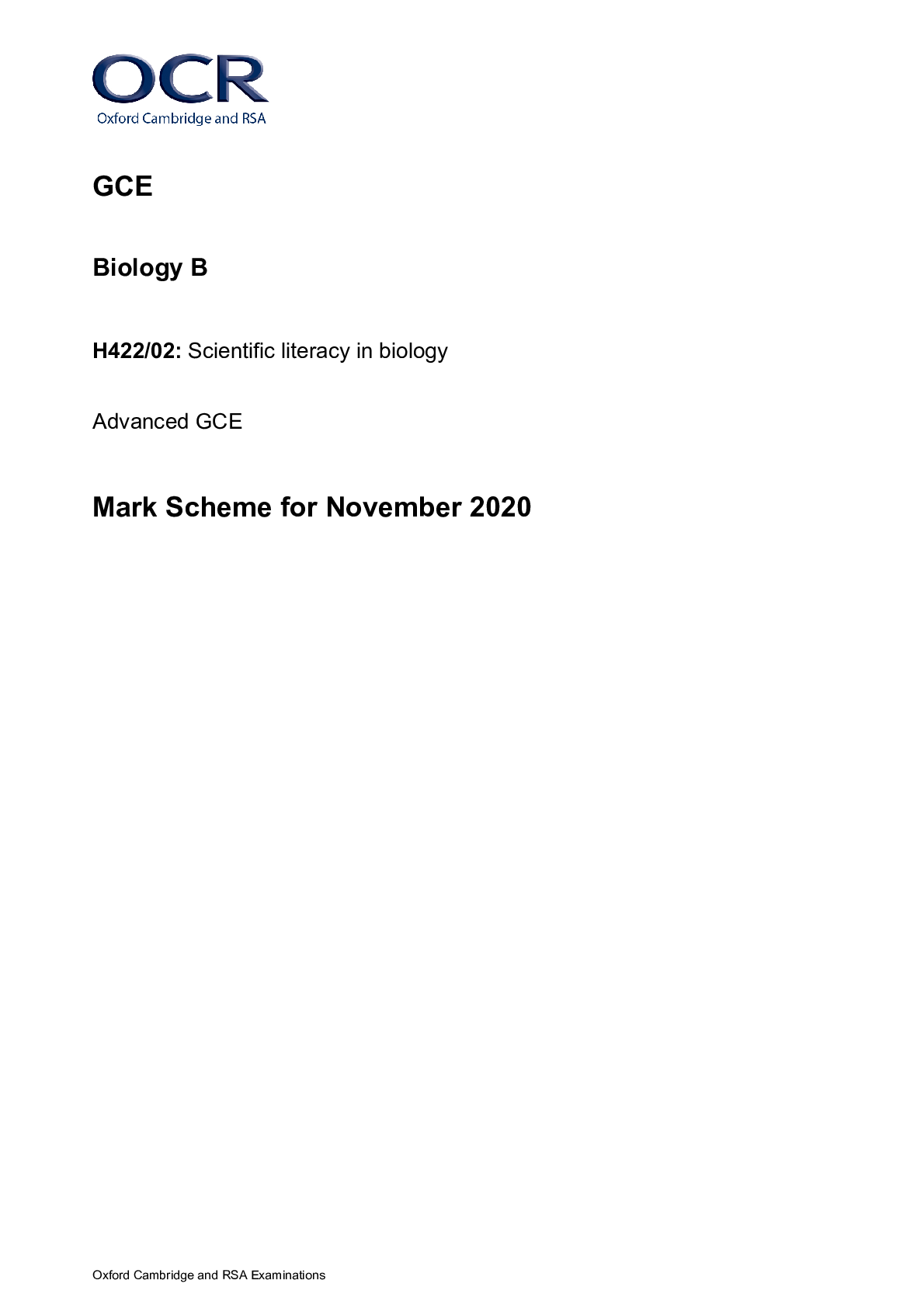
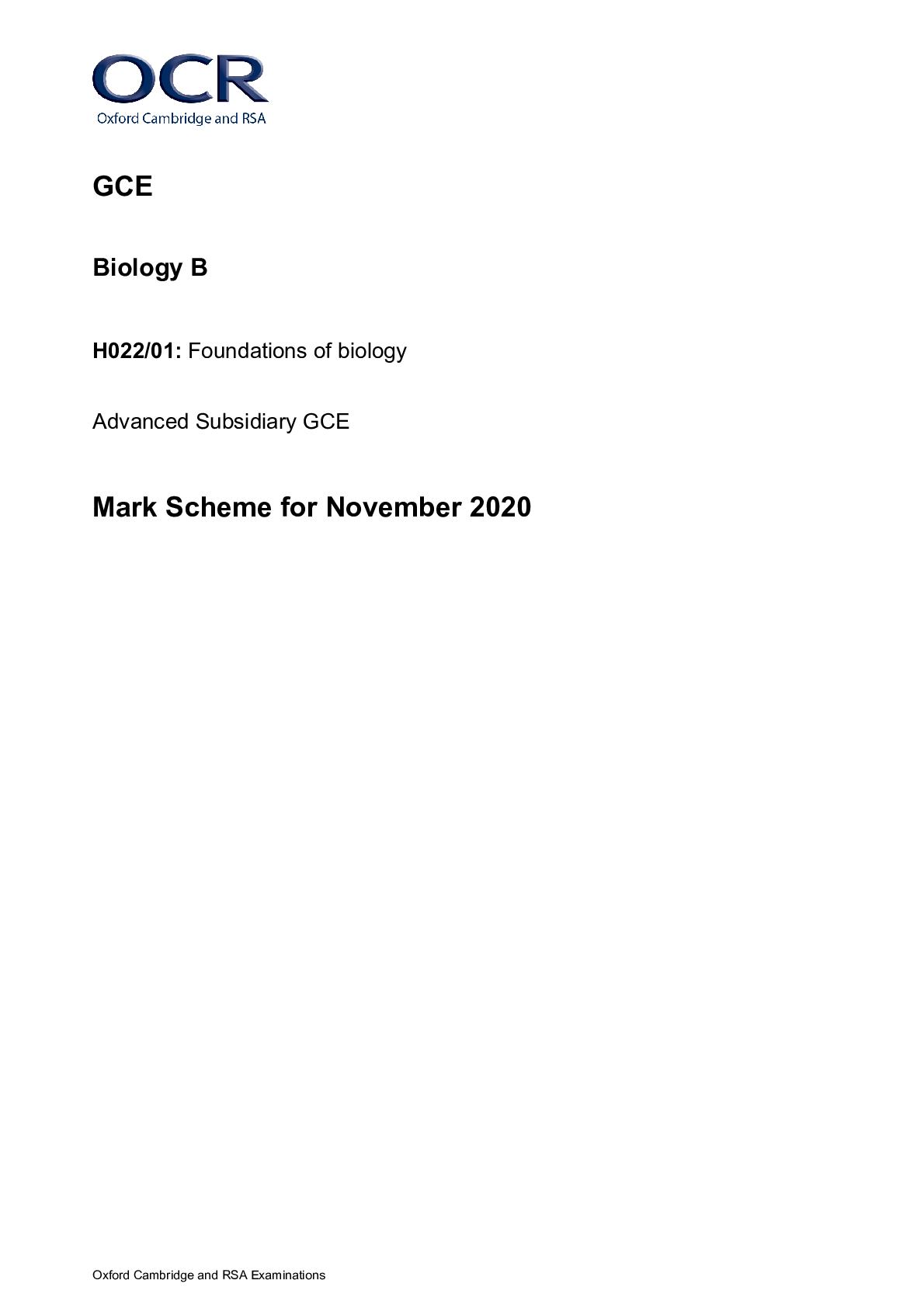



.png)
